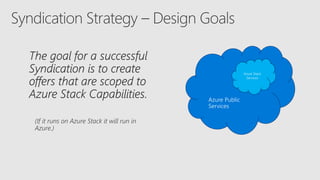How you as an ISV can build your app for the Azure Marketplace and have it syndicated to the Azure Stack
- 9. Azure Stack Subscribers Customer Scenarios that you are already delivering today… Help TENANTS use, optimize, orchestrate, consume, manage, protect their Azure Stack workloads. Deliver TENANT deployable appliances, clusters, solutions… Azure Stack Operators New and Different scenarios than Azure Help Azure Stack OWNERS deliver orchestrate, sell, manage, protect and monetize their Azure Stacks. Customers New to Azure Azure Stack is resonating with customers who are completely new to Azure Help New Azure customers learn about and capitalize Azure/Azure Stack. Via: • Software solutions • Engagements • Partnerships with SI’s • Managed experiences
- 10. Azure Public Marketplace Azure Stack Marketplace Syndicated Marketplace Offers Azure Stack Marketplace Azure Stack Marketplace Azure Marketplace is the quickest and simplest way that customers can acquire and deploy your software on Azure. Every Azure Stack has essentially the same marketplace storefront but NOTHING is on the shelves. Azure Stack Administrators stock their marketplaces with offers from Azure via syndication, or customer offers that they build.
- 12. Azure Certified Marketplace Offer Business and Technical Review Push to Private Syndication ISV Fix ISV Test on Stack Update Azure Offer Notify azStackSyndication@ Microsoft.com Publish in Public Syndication Feed Reap the rewardsEnd to End Validation Things to do All Good Still things to do
- 13. Business Requirements BYOL Licensed offers only at this time. Technical Requirements • Supported artifact type VM VM Extension Solution Templates that use a single VM artifact • Run on IaaS instances available on Stack • Use Services/Versions Available on Stack
- 17. 1 2 3 Develop Validate Syndicate [email protected]



















